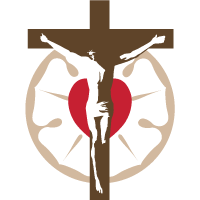by Rev. Matthew Zickler
Have you ever been to a Christian store and noticed that they had something which listed the commandments, but it didn’t have the same numbering that you learned when you memorized the Catechism? In particular, the Second Commandment was listed as “You shall not make for yourself any graven image.” Or have you ever been inside a church where there was nothing on the walls: no pictures, possibly not even a cross, definitely not a crucifix? Did you ever wonder why?
 Simply put (of course things like this are never entirely simple) this comes from people in the church called iconoclasts. Iconoclasts are those who destroy images. There have been iconoclasts appearing throughout the history of the church. For example, there was even a council that met in Nicea in 787 (not the council that led to the Nicene Creed) that addressed the concerns of those who desired to destroy images. At the time of Luther, one of his colleagues at Wittenberg, Andreas Bodenstein von Karlstadt, adopted iconoclastic views and began wreaking havoc while Luther was in hiding at the Wartburg Castle from 1521-1522. It was during this time that Karlstadt took over the role as the lead reformer at Wittenberg and began instructing people to destroy every sort of image they could find. They destroyed windows with images, they destroyed statues, they even pulled down altars with carvings of people. They demolished the church along with many other historical landmarks in Wittenberg.
Simply put (of course things like this are never entirely simple) this comes from people in the church called iconoclasts. Iconoclasts are those who destroy images. There have been iconoclasts appearing throughout the history of the church. For example, there was even a council that met in Nicea in 787 (not the council that led to the Nicene Creed) that addressed the concerns of those who desired to destroy images. At the time of Luther, one of his colleagues at Wittenberg, Andreas Bodenstein von Karlstadt, adopted iconoclastic views and began wreaking havoc while Luther was in hiding at the Wartburg Castle from 1521-1522. It was during this time that Karlstadt took over the role as the lead reformer at Wittenberg and began instructing people to destroy every sort of image they could find. They destroyed windows with images, they destroyed statues, they even pulled down altars with carvings of people. They demolished the church along with many other historical landmarks in Wittenberg.
Why did these people do this? Why did Karlstadt instruct them to do this? The answer flows from how Karlstad read the commandments. He read the commandment that one should make no graven images, and he applied that to any image. He said that if someone made an image of something in heaven, on the earth, or below the earth, then he is breaking the commandment and is guilty of idolatry. Perhaps you’ve heard that argument before. In fact, this argument is often connected to why many churches don’t have crucifixes: Jesus’ body is created, likewise that body is now in heaven (a misreading of the command which speaks about making images of creatures of the air like birds), and therefore one ought not create an image of that body. This is iconoclasm.
 So what did Luther do in response to this? The havoc caused by Karlstadt was actually the reason Luther came out of hiding. Karlstadt had created such anarchy in Wittenberg that Luther wanted to come and care for the people who were cowering in fear of the iconoclasts. Likewise, he wanted to provide care and instruction for the people that they would understand properly how to deal with images. To do this, he preached what are called the Invocavit sermons. These were sermons preached during the week after the first Sunday in Lent (which historically has been called Invocavit or Quadragesima Sunday). In these sermons he taught the people about how change should occur in the church: not by violence or force but by the work of the Word and the conviction of the Gospel. His dealings with the iconoclasts didn’t end there, though.
So what did Luther do in response to this? The havoc caused by Karlstadt was actually the reason Luther came out of hiding. Karlstadt had created such anarchy in Wittenberg that Luther wanted to come and care for the people who were cowering in fear of the iconoclasts. Likewise, he wanted to provide care and instruction for the people that they would understand properly how to deal with images. To do this, he preached what are called the Invocavit sermons. These were sermons preached during the week after the first Sunday in Lent (which historically has been called Invocavit or Quadragesima Sunday). In these sermons he taught the people about how change should occur in the church: not by violence or force but by the work of the Word and the conviction of the Gospel. His dealings with the iconoclasts didn’t end there, though.
Over the course of the next few years, Karlstadt moved on and became connected with other movements which came to be known as the Radical Reformation. These movements included leaders such as Thomas Münzer and groups such as the Anabaptists, who, as their name indicates, “baptized again” because they rejected the baptism of infants. Karlstadt adopted many teachings that these movements had, including the rejection of the sacraments and the denial of the pastoral office as a divinely given office in the church. Luther eventually addressed all of these false teachings publicly in a work called “Against the Heavenly Prophets.” This title referenced the tendency of these groups to deny the need for the external Word, that is, the Scripture and the Gospel preached, in order to receive revelation. In that work, Luther dedicates a portion specifically to the iconoclastic teachings of Karlstadt and the others.
Luther points out that he too has been dedicated to destroying images: “I approached the task of destroying images by first tearing them out of the heart through God’s Word and making them worthless and despised. This indeed took place before Dr. Karlstadt ever dreamed of destroying images. For when they are no longer in the heart, they can do no harm when seen with the eyes. But Dr. Karlstadt, who pays no attention to matters of the heart, has reversed the order by removing them from sight and leaving them in the heart. For he does not preach faith, nor can he preach it; unfortunately, only now do I see that. Which of these two forms of destroying images is best, I will let each man judge for himself.” (AE 40, 85). So Luther clearly decries an ungodly attachment to images. He sees this question as a matter of the heart, so that the heart would first find them worthless and despised. This is consistent with what he also says regarding the First Commandment in the Large Catechism: “The heathen really make their self-invented notions and dreams of God and idol. Ultimately, they put their trust in that which is nothing. So it is with all idolatry. For it happens not merely by erecting an image and worshipping it, but rather it happens in the heart. For the heart seeks help and consolation from creatures, saints, or devils. It neither cares for God, nor looks to Him for anything better than to believe that He is willing to help.” (LC 1, 20-21)
With the understanding that such images are idolatrous—an issue of the heart which must be dealt with on that level—Luther clarifies just what he means by “images” later in “Against the Heavenly Prophets”. He says, “I will first discuss images according to the Law of Moses, and then according to the gospel. And I say at the outset that according to the Law of Moses no other images are forbidden than an image of God which one worships. A crucifix, on the other hand, or any other holy image is not forbidden. Heigh now! you breakers of images, I defy you to prove the opposite!” (AE 40:85-86) In fact, he clarifies just what this means all the more when he says, “Now I say this to keep the conscience free from mischievous laws and fictitious sins, and not because I would defend images. Nor would I condemn those who have destroyed them, especially those who destroy divine and idolatrous images. But images for memorial and witness, such as crucifixes and images of saints, are to be tolerated.” (AE 40: 91)
Luther clearly points out the issue. If someone is worshipping an image, that’s a problem. If they show service in their heart to that image, that must change. They mustn’t worship a created thing as though it were God. But there is no Law against creating a statue or picture of something. If there were, there then would be a problem with the Bronze Serpent (Numbers 21:1-9) commanded by God. There was no problem with it until people worshiped it and served it with their heart, leading Hezekiah to destroy it (II Kings 18:4, cf AE 40:87). However, if there is not a problem in the heart, then it is not sinful to use images to remember our Lord’s work and to testify to the blessed Gospel of our forgiveness by the work of Jesus alone. In fact, it can even be edifying.
 So then, when you see pictures in a church depicting Bible stories, give thanks as you remember our Lord’s promise to save His people and redeem them. All the more, as you see the body of Christ on a crucifix, remember His sacrifice for you, for if there was no cross of Christ, then your sins are still yours. But by the cross, Christ has shed His blood and died for your sins. He has also risen to give you new life. In that new life enjoy the freedom to utilize images to assist your devotion to our Lord as you meditate on and memorialize His work. Do so gladly, knowing as Luther said, that “the confidence and faith of the heart alone make both God and an idol.” (LC 1, 2).
So then, when you see pictures in a church depicting Bible stories, give thanks as you remember our Lord’s promise to save His people and redeem them. All the more, as you see the body of Christ on a crucifix, remember His sacrifice for you, for if there was no cross of Christ, then your sins are still yours. But by the cross, Christ has shed His blood and died for your sins. He has also risen to give you new life. In that new life enjoy the freedom to utilize images to assist your devotion to our Lord as you meditate on and memorialize His work. Do so gladly, knowing as Luther said, that “the confidence and faith of the heart alone make both God and an idol.” (LC 1, 2).
The Rev. Matthew Zickler is pastor of Grace Lutheran Church, Western Springs, IL.
